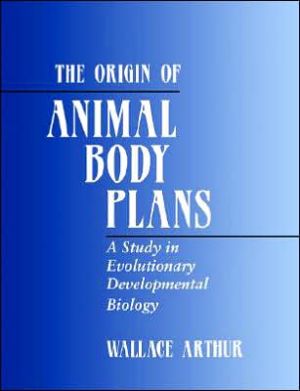The Origin of Animal Body Plans: A Study in Evolutionary Developmental Biology
While neo-Darwinism has considerable explanatory power, it is widely recognized as lacking a component dealing with individual development, or ontogeny. This lack is particularly conspicuous when attempting to explain the evolutionary origin of the thirty-five or so animal body plans, and of the developmental trajectories that generate them. This significant work examines both the origin of body plans in particular and the evolution of animal development in general. Wallace Arthur ranges...
Search in google:
This book examines both the origin of body plans in particular and the evolution of animal development in general.
Preface; Acknowledgements; Part I. Introduction: 1.1 A developmental approach to an evolutionary problem; 1.2 The early history of the animal kingdom; 1.3 Alternative strategies; 1.4 Creation versus destruction; 1.5 Systematics and the concept of natural classification; 1.6 Micromutation versus macromutation; 1.7 Developing organisms as inverted cones; Part II. What is a Body Plan?: 2.1 Body plans and taxonomic levels; 2.2 Body plans, cladograms and homology; 2.3 Body plans and embryology; 2.4 Body plans, genes and mutations; 2.5 Body plans, adaptation and environments; Part III. Patterns of Body Plan Origins: 3.1 Strategy; 3.2 Patterns of metazoan inter-relationships; 3.3 Early fossils: from cladograms to trees; 3.4 Bringing back morphology; 3.5 Paleoecology and possible adaptive scenarios; Part IV. Evolutionary Developmental Biology: 4.1 From pattern to mechanism; 4.2 The aims of Evolutionary Developmental Biology; 4.3 A brief history; 4.4 Is there a theory of development?; Part V. Developmental Mechanisms: Cells and Signals: 5.1 Strategy; 5.2 Cellular processes and architecture; 5.3 Short-range signals: cell-cell contacts; 5.4 Mid-range signals and the nature of 'morphogens'; 5.5 Long-range signals and pan-organismic co-ordination; 5.6 Patterns of interconnection: developmental programmes; Part VI. Developmental Mechanisms: Genes: 6.1 Introduction; 6.2 Overview of the genetics of Drosophila body axes; 6.3 The Antennapedia and Bithorax complexes; 6.4 The hedgehog gene and limb development; 6.5 Developmental programmes and an evolutionary message; Part VII. Comparative Developmental Genetics: 7.1 From developmentto evolution; 7.2 Phylogeny of Hox genes; 7.3 Dorso-ventral polarity in arthropods and chordates; 7.4 Limb formation, hedgehog, and the nature of homology; 7.5 Phylogeny of cadherin genes; 7.6 Emergent evolutionary messages; Part VIII. Gene Duplication and Mutation: 8.1 Introduction; 8.2 The creation of new genes; 8.3 Mutation: the classical approach; 8.4 Mutation: a developmental approach; 8.5 Mutation and the evolution of development; Part IX. The Spread of Variant Ontogenies in Populations: 9.1 Introduction; 9.2 Population genetic models of directional selection; 9.3 Internal selection; 9.4 The origin of body plans: a population perspective; 9.5 Types of genetic change; 9.6 Drift, drive and directed mutation; Part X. Creation Versus Destruction: 10.1 A fourth 'eternal metaphor'?; 10.2 Mutationists v. selectionists: a protracted debate; 10.3 The structure of morphospace; 10.4 Creation and destruction; Part XI. Ontogeny and Phylogeny Re-Visited: 11.1 Mapping the two hierarchies; 11.2 From two hierarchies to six; 11.3 An important general pattern; 11.4 Larval forms and complex life histories; 11.5 Phenotypic complexity and evolutionary 'explosions'; Part XII. Prospect: Expanding the Synthesis: 12.1 Neither boredom nor heresy; 12.2 Completing the evolutionary circle; 12.3 The main themes of Evolutionary Developmental Biology; 12.4 Paths into the future; References; Index.








